BUS-FP3062 - Fundamentals of Finance: Risk and Return Assessment
VerifiedAdded on 2022/08/22
|6
|789
|20
Homework Assignment
AI Summary
This assignment, completed for a Fundamentals of Finance course, addresses key concepts in financial risk and return. It begins by defining risk and its measurement through volatility, explaining the difference between actual and expected returns. The assignment then distinguishes between market risk and firm-specific risk, emphasizing how they affect investments. The coefficient of variation is explained as a measure of relative variability, with examples illustrating its application in comparing investment results. The solution includes calculations for dollar and percentage return on an investment, and the assignment concludes with a comparative analysis of risk and return for different companies (Conglomco, Supercorp, and Megaorg), calculating the coefficient of variation for each and determining portfolio return based on weighted returns.
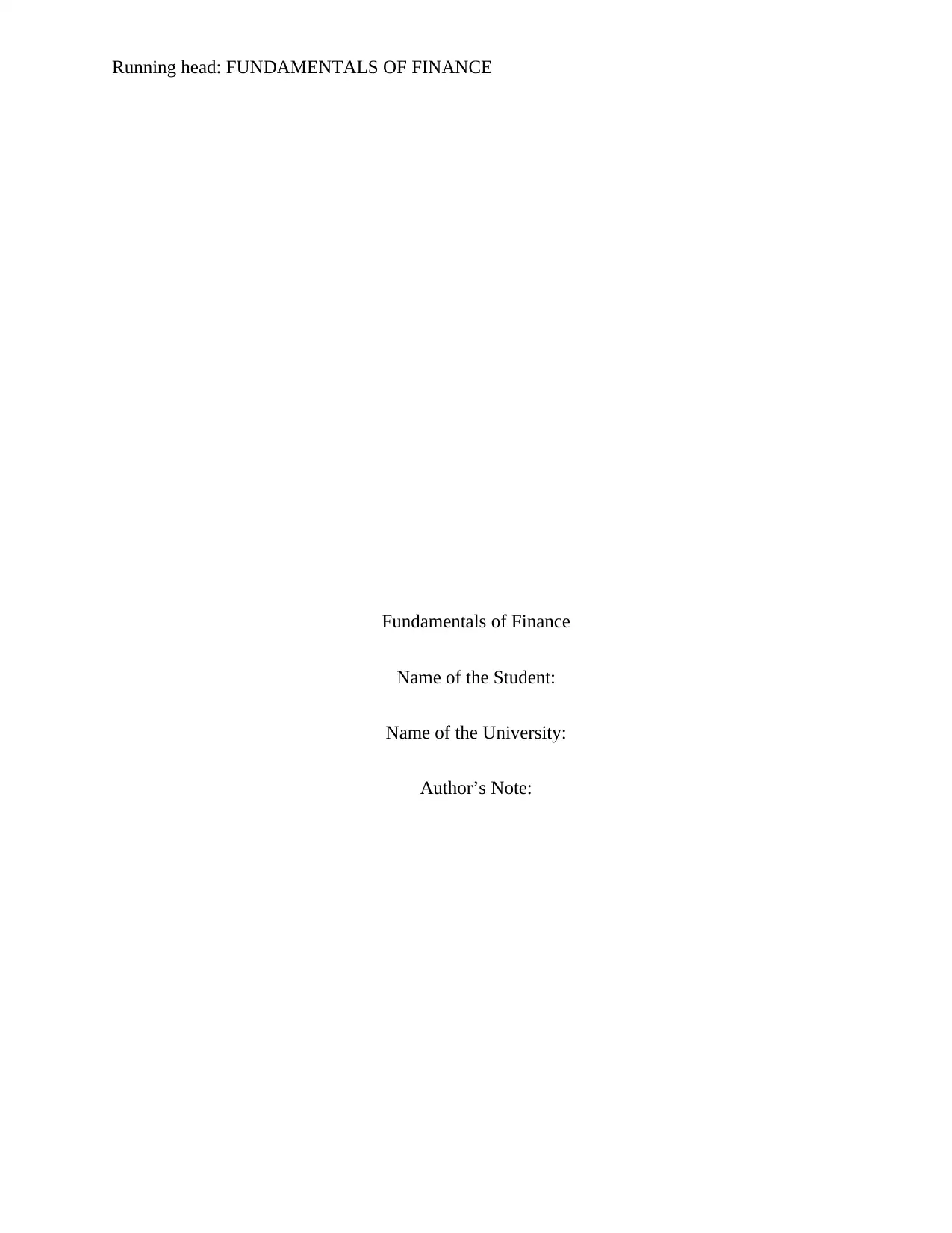
Running head: FUNDAMENTALS OF FINANCE
Fundamentals of Finance
Name of the Student:
Name of the University:
Author’s Note:
Fundamentals of Finance
Name of the Student:
Name of the University:
Author’s Note:
Paraphrase This Document
Need a fresh take? Get an instant paraphrase of this document with our AI Paraphraser
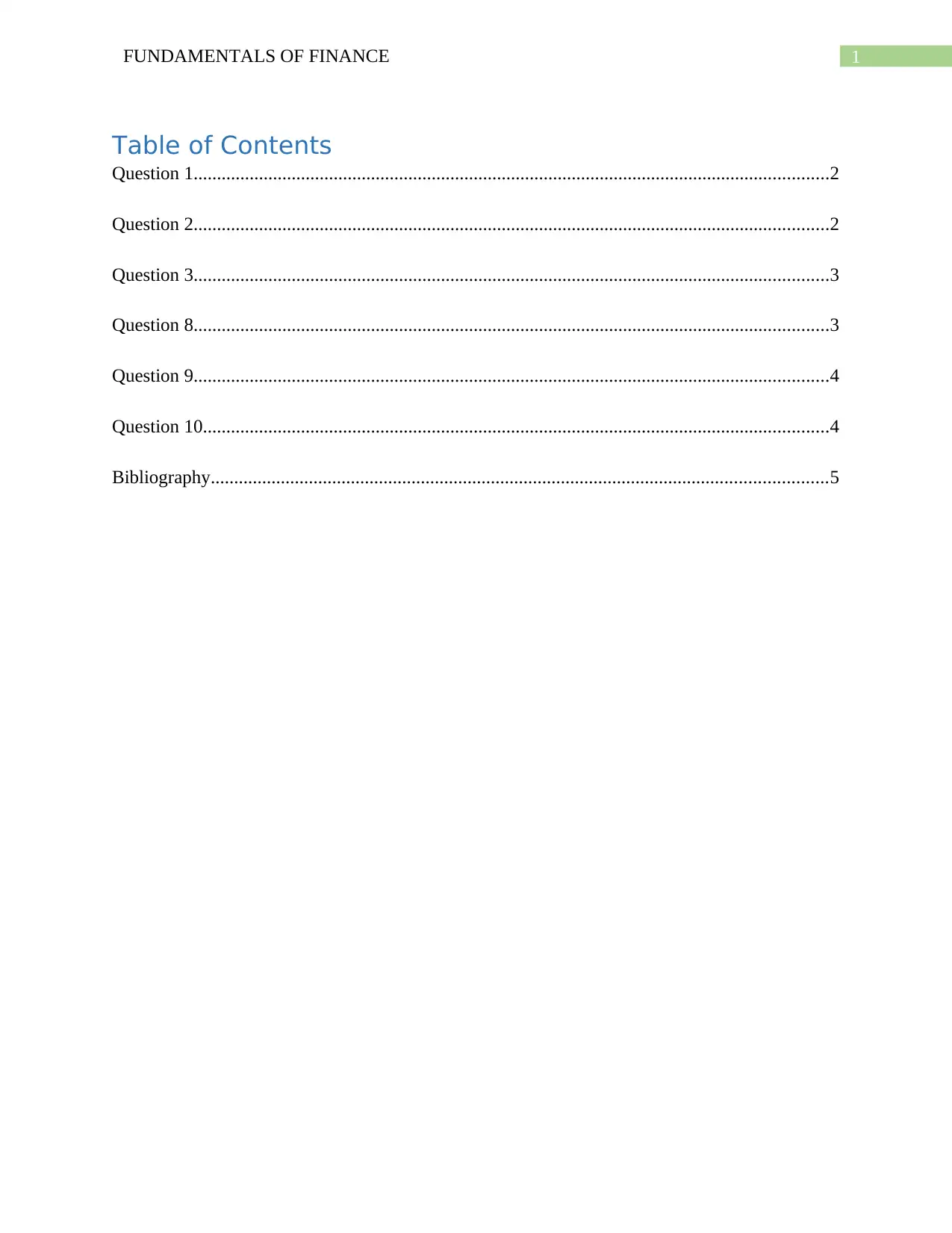
1FUNDAMENTALS OF FINANCE
Table of Contents
Question 1........................................................................................................................................2
Question 2........................................................................................................................................2
Question 3........................................................................................................................................3
Question 8........................................................................................................................................3
Question 9........................................................................................................................................4
Question 10......................................................................................................................................4
Bibliography....................................................................................................................................5
Table of Contents
Question 1........................................................................................................................................2
Question 2........................................................................................................................................2
Question 3........................................................................................................................................3
Question 8........................................................................................................................................3
Question 9........................................................................................................................................4
Question 10......................................................................................................................................4
Bibliography....................................................................................................................................5
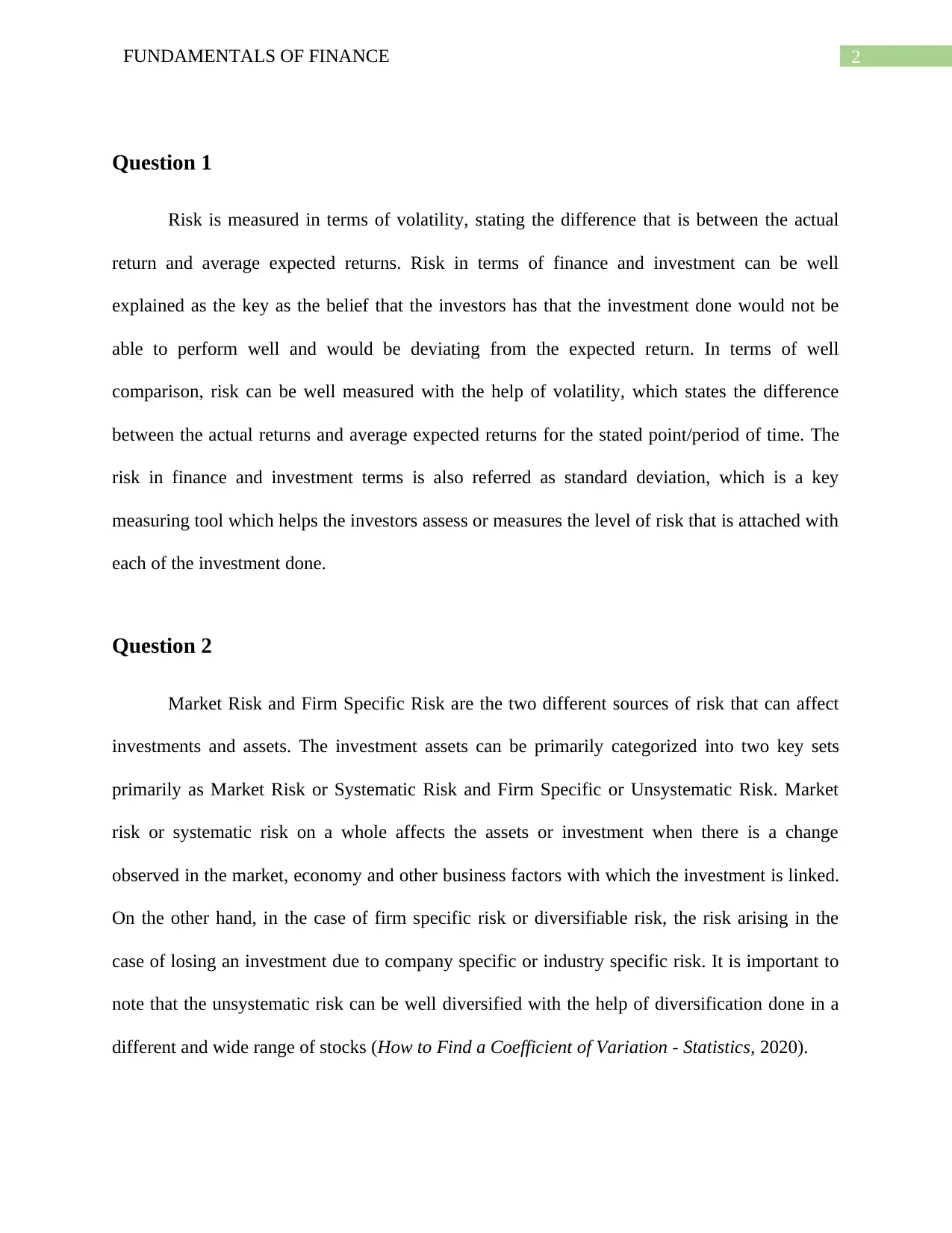
2FUNDAMENTALS OF FINANCE
Question 1
Risk is measured in terms of volatility, stating the difference that is between the actual
return and average expected returns. Risk in terms of finance and investment can be well
explained as the key as the belief that the investors has that the investment done would not be
able to perform well and would be deviating from the expected return. In terms of well
comparison, risk can be well measured with the help of volatility, which states the difference
between the actual returns and average expected returns for the stated point/period of time. The
risk in finance and investment terms is also referred as standard deviation, which is a key
measuring tool which helps the investors assess or measures the level of risk that is attached with
each of the investment done.
Question 2
Market Risk and Firm Specific Risk are the two different sources of risk that can affect
investments and assets. The investment assets can be primarily categorized into two key sets
primarily as Market Risk or Systematic Risk and Firm Specific or Unsystematic Risk. Market
risk or systematic risk on a whole affects the assets or investment when there is a change
observed in the market, economy and other business factors with which the investment is linked.
On the other hand, in the case of firm specific risk or diversifiable risk, the risk arising in the
case of losing an investment due to company specific or industry specific risk. It is important to
note that the unsystematic risk can be well diversified with the help of diversification done in a
different and wide range of stocks (How to Find a Coefficient of Variation - Statistics, 2020).
Question 1
Risk is measured in terms of volatility, stating the difference that is between the actual
return and average expected returns. Risk in terms of finance and investment can be well
explained as the key as the belief that the investors has that the investment done would not be
able to perform well and would be deviating from the expected return. In terms of well
comparison, risk can be well measured with the help of volatility, which states the difference
between the actual returns and average expected returns for the stated point/period of time. The
risk in finance and investment terms is also referred as standard deviation, which is a key
measuring tool which helps the investors assess or measures the level of risk that is attached with
each of the investment done.
Question 2
Market Risk and Firm Specific Risk are the two different sources of risk that can affect
investments and assets. The investment assets can be primarily categorized into two key sets
primarily as Market Risk or Systematic Risk and Firm Specific or Unsystematic Risk. Market
risk or systematic risk on a whole affects the assets or investment when there is a change
observed in the market, economy and other business factors with which the investment is linked.
On the other hand, in the case of firm specific risk or diversifiable risk, the risk arising in the
case of losing an investment due to company specific or industry specific risk. It is important to
note that the unsystematic risk can be well diversified with the help of diversification done in a
different and wide range of stocks (How to Find a Coefficient of Variation - Statistics, 2020).
⊘ This is a preview!⊘
Do you want full access?
Subscribe today to unlock all pages.

Trusted by 1+ million students worldwide
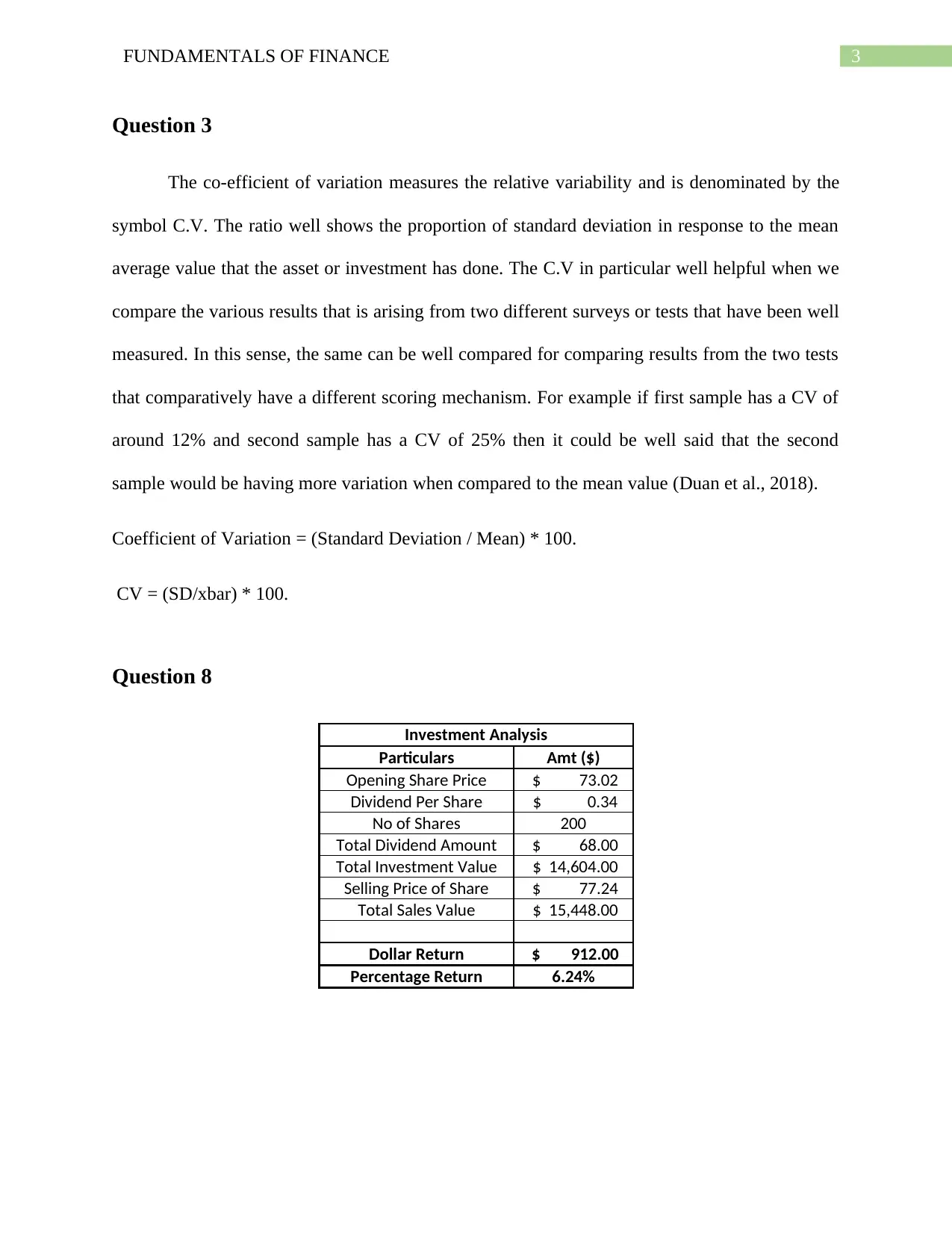
3FUNDAMENTALS OF FINANCE
Question 3
The co-efficient of variation measures the relative variability and is denominated by the
symbol C.V. The ratio well shows the proportion of standard deviation in response to the mean
average value that the asset or investment has done. The C.V in particular well helpful when we
compare the various results that is arising from two different surveys or tests that have been well
measured. In this sense, the same can be well compared for comparing results from the two tests
that comparatively have a different scoring mechanism. For example if first sample has a CV of
around 12% and second sample has a CV of 25% then it could be well said that the second
sample would be having more variation when compared to the mean value (Duan et al., 2018).
Coefficient of Variation = (Standard Deviation / Mean) * 100.
CV = (SD/xbar) * 100.
Question 8
Investment Analysis
Particulars Amt ($)
Opening Share Price $ 73.02
Dividend Per Share $ 0.34
No of Shares 200
Total Dividend Amount $ 68.00
Total Investment Value $ 14,604.00
Selling Price of Share $ 77.24
Total Sales Value $ 15,448.00
Dollar Return $ 912.00
Percentage Return 6.24%
Question 3
The co-efficient of variation measures the relative variability and is denominated by the
symbol C.V. The ratio well shows the proportion of standard deviation in response to the mean
average value that the asset or investment has done. The C.V in particular well helpful when we
compare the various results that is arising from two different surveys or tests that have been well
measured. In this sense, the same can be well compared for comparing results from the two tests
that comparatively have a different scoring mechanism. For example if first sample has a CV of
around 12% and second sample has a CV of 25% then it could be well said that the second
sample would be having more variation when compared to the mean value (Duan et al., 2018).
Coefficient of Variation = (Standard Deviation / Mean) * 100.
CV = (SD/xbar) * 100.
Question 8
Investment Analysis
Particulars Amt ($)
Opening Share Price $ 73.02
Dividend Per Share $ 0.34
No of Shares 200
Total Dividend Amount $ 68.00
Total Investment Value $ 14,604.00
Selling Price of Share $ 77.24
Total Sales Value $ 15,448.00
Dollar Return $ 912.00
Percentage Return 6.24%
Paraphrase This Document
Need a fresh take? Get an instant paraphrase of this document with our AI Paraphraser
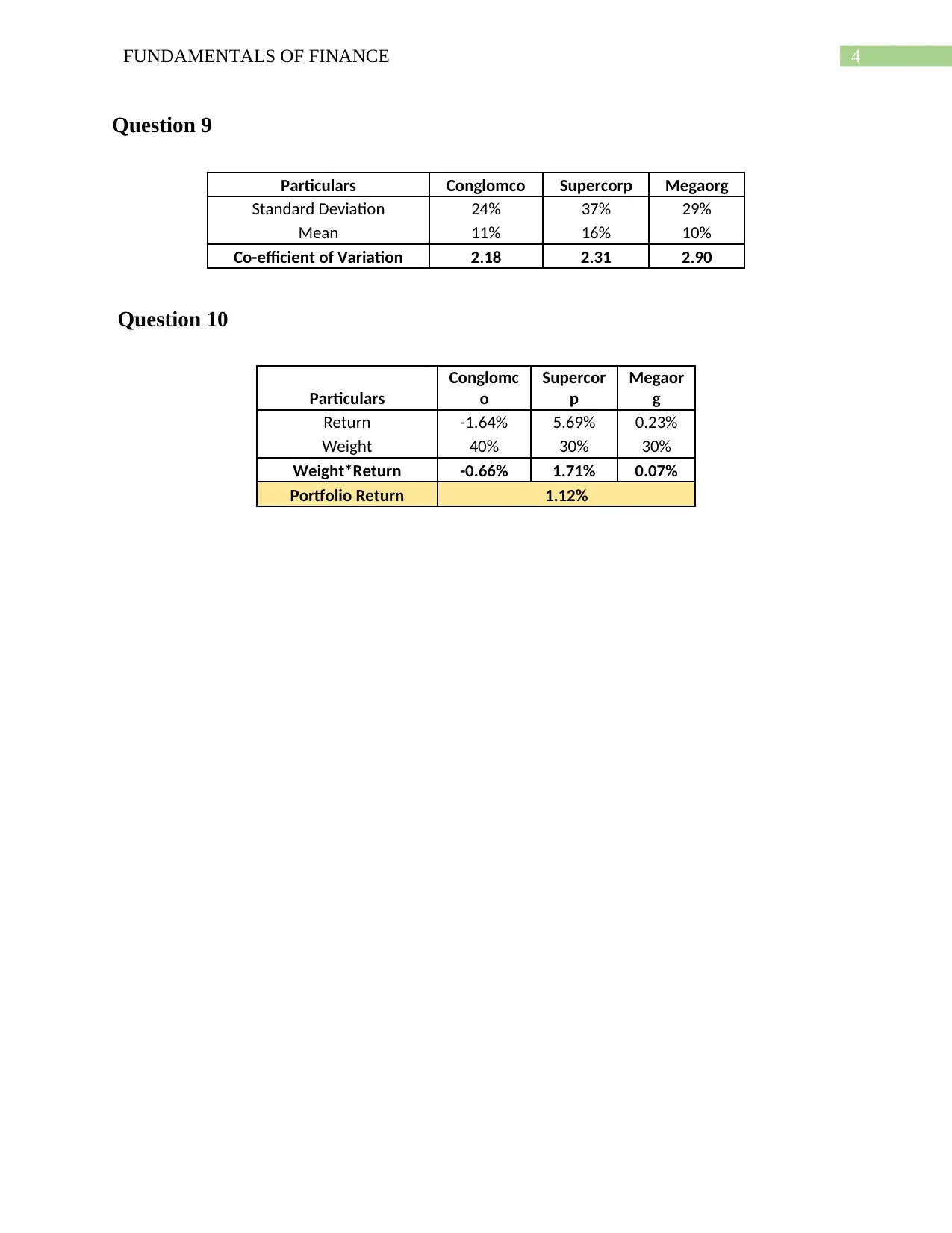
4FUNDAMENTALS OF FINANCE
Question 9
Particulars Conglomco Supercorp Megaorg
Standard Deviation 24% 37% 29%
Mean 11% 16% 10%
Co-efficient of Variation 2.18 2.31 2.90
Question 10
Particulars
Conglomc
o
Supercor
p
Megaor
g
Return -1.64% 5.69% 0.23%
Weight 40% 30% 30%
Weight*Return -0.66% 1.71% 0.07%
Portfolio Return 1.12%
Question 9
Particulars Conglomco Supercorp Megaorg
Standard Deviation 24% 37% 29%
Mean 11% 16% 10%
Co-efficient of Variation 2.18 2.31 2.90
Question 10
Particulars
Conglomc
o
Supercor
p
Megaor
g
Return -1.64% 5.69% 0.23%
Weight 40% 30% 30%
Weight*Return -0.66% 1.71% 0.07%
Portfolio Return 1.12%
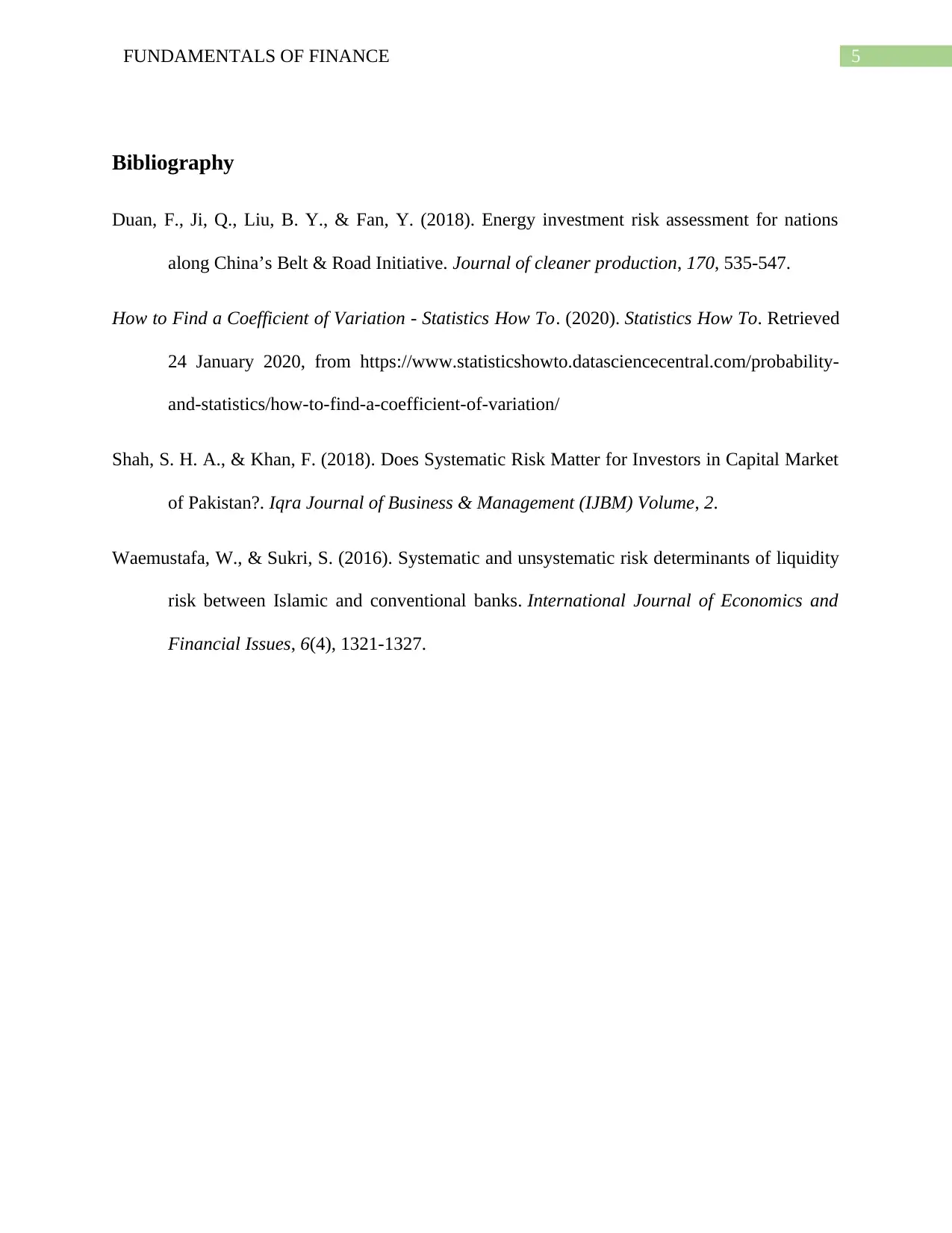
5FUNDAMENTALS OF FINANCE
Bibliography
Duan, F., Ji, Q., Liu, B. Y., & Fan, Y. (2018). Energy investment risk assessment for nations
along China’s Belt & Road Initiative. Journal of cleaner production, 170, 535-547.
How to Find a Coefficient of Variation - Statistics How To. (2020). Statistics How To. Retrieved
24 January 2020, from https://www.statisticshowto.datasciencecentral.com/probability-
and-statistics/how-to-find-a-coefficient-of-variation/
Shah, S. H. A., & Khan, F. (2018). Does Systematic Risk Matter for Investors in Capital Market
of Pakistan?. Iqra Journal of Business & Management (IJBM) Volume, 2.
Waemustafa, W., & Sukri, S. (2016). Systematic and unsystematic risk determinants of liquidity
risk between Islamic and conventional banks. International Journal of Economics and
Financial Issues, 6(4), 1321-1327.
Bibliography
Duan, F., Ji, Q., Liu, B. Y., & Fan, Y. (2018). Energy investment risk assessment for nations
along China’s Belt & Road Initiative. Journal of cleaner production, 170, 535-547.
How to Find a Coefficient of Variation - Statistics How To. (2020). Statistics How To. Retrieved
24 January 2020, from https://www.statisticshowto.datasciencecentral.com/probability-
and-statistics/how-to-find-a-coefficient-of-variation/
Shah, S. H. A., & Khan, F. (2018). Does Systematic Risk Matter for Investors in Capital Market
of Pakistan?. Iqra Journal of Business & Management (IJBM) Volume, 2.
Waemustafa, W., & Sukri, S. (2016). Systematic and unsystematic risk determinants of liquidity
risk between Islamic and conventional banks. International Journal of Economics and
Financial Issues, 6(4), 1321-1327.
⊘ This is a preview!⊘
Do you want full access?
Subscribe today to unlock all pages.

Trusted by 1+ million students worldwide
1 out of 6
Related Documents
Your All-in-One AI-Powered Toolkit for Academic Success.
+13062052269
info@desklib.com
Available 24*7 on WhatsApp / Email
![[object Object]](/_next/static/media/star-bottom.7253800d.svg)
Unlock your academic potential
Copyright © 2020–2025 A2Z Services. All Rights Reserved. Developed and managed by ZUCOL.





